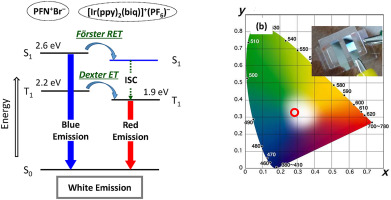Organic Electronics ( IF 2.7 ) Pub Date : 2017-09-06 , DOI: 10.1016/j.orgel.2017.09.003 Yoshinori Nishikitani , Kotaro Suga , Soichi Uchida , Suzushi Nishimura , Kenichi Oyaizu , Hiroyuki Nishide

|
The authors present high-color-rendering-index (CRI) white polymer light-emitting electrochemical cells (PLECs) based on ionic host-guest systems. PLECs were fabricated with blend films composed of a blue fluorescent cationic π-conjugated polymer, poly(9,9-bis[6′-(N,N,N,-trimethylammonium)hexyl]fluorine-co-alt-1,4-phenylene)bromide (PFN+Br−), used as a host, and a red phosphorescent cationic iridium complex, [Ir(ppy)2(biq)]+(PF6)− (where (ppy)− = 2-phenylpyridinate and biq = 2,2′-biquinoline), used as a guest. By optimizing the composition of PFN+Br− and [Ir(ppy)2(biq)]+(PF6)− in the active layers, white light emission with Commission Internationale de l'Eclairage (CIE) coordinates of (x = 0.28, y = 0.31) and a very high CRI of 95.8 was achieved through mixing of blue and red light at an applied voltage of 4.0 V. The white light emissions were obtained at a low [Ir(ppy)2(biq)]+(PF6)− concentration (PFN+Br−:[Ir(ppy)2(biq)]+(PF6)− = 1:0.01 (mass ratio)), showing that [Ir(ppy)2(biq)]+(PF6)− acts as a suitable energy acceptor. The emission mechanism of the ionic host-guest PLECs can be explained by Förster resonance energy transfer (FRET) and Dexter energy transfer (DET) from the excited PFN+Br− to [Ir(ppy)2(biq)]+(PF6)−. Utilization of ionic host-guest PLECs is a very promising method for realizing white light-emitting devices with very high CRI.
中文翻译:

基于离子型主客体系统的高显色指数白色聚合物发光电化学电池:蓝色荧光阳离子聚芴和红色荧光阳离子铱配合物的共混膜的利用
作者介绍了基于离子型主客体系统的高显色指数(CRI)白色聚合物发光电化学电池(PLEC)。PLEC用共混膜制成,共混膜由蓝色荧光阳离子π共轭聚合物,聚(9,9-双[6'-(N,N,N,-三甲基铵)己基]氟-共-alt-1,4-组成亚苯基)溴化镁(PFN +溴- ),作为宿主,和红色磷光阳离子铱络合物,[的Ir(ppy)2(BIQ)] +(PF 6)- (其中,(PPY)- = 2- phenylpyridinate和biq = 2,2'-biquinoline),用作来宾。通过优化PFN的组成+溴-和[的Ir(ppy)2(BIQ)] +(PF 6)-中的有源层,白光委员会国际照明委员会(CIE)发射坐标(x = 0.28,Y = 0.31)和通过在4.0 V的施加电压下混合蓝光和红光,可以实现95.8的非常高的CRI。白光发射是在低[Ir(ppy)2(biq)] +(PF 6)-浓度( PFN + Br -:[Ir(ppy)2(biq)] +(PF 6)- = 1:0.01(质量比)),表明[Ir(ppy)2(biq)] +(PF 6)-充当合适的能量受体。离子主客体PLECS的发射机构可以通过共振能量转移(FRET)和从激发PFN德克斯特能量转移(DET)进行说明+溴-为[的Ir(ppy)2(BIQ)] +(PF 6)-。利用离子型客体PLEC是一种非常有前途的方法,可以实现具有很高CRI的发白光器件。











































 京公网安备 11010802027423号
京公网安备 11010802027423号